3.1 BABY FORMATION
Among human beings we find mother and father, the parents. The mother in human beings gives birth to babies that resemble their parents. Babies then grow into young adults. Method of reproduction is sexual reproduction. Basic process of sexual reproduction in human beings is the same as in all other animals. Both males and females bear special reproductive cells, the gametes. The male gamete is the sperm and the female gamete is the ovum (the egg cell). The two gametes unite during fertilization forming zygote. Fertilization in human beings is internal since it takes place inside the body of the female (mother). Zygote develops into an embryo and embryo into a baby. Baby may be a girl or a boy. Mother gives birth to a baby.

3.2 REPRODUCTIVE ORGANS
A. The Male Sex Organs
(a) A pair of testes (singular is testis). Each testis lies in a scrotal sac. The scrotal sacs lie hang outside the body. Millions of sperms (male gametes) are produced within the testes everyday stored in epididymis. When a boy reaches puberty, the testes are stimulated by the pituitary gl to produce ‘testosterone’, the male sex hormone. This hormone stimulates the formation of sperms.
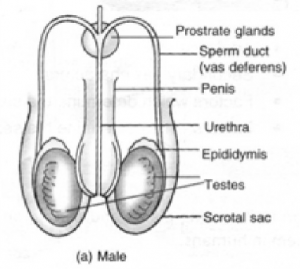
(b) Epididymis is one on each testis. It stores sperms till they are pushed out of the urethra. M of the sperms may stay in the epididymis, where they eventually die and are reabsorbed into tests.
(c) Vas deferens are a pair of sperm ducts running from epididymis to the urethra on penis. They carry the sperms through them.
(d) Penis, the muscular organ having a drainage duct (urethra) inside through which urine a sperms are pushed out.
The sperm is a male gamete with a head, body and a long tail (flagellum). The head bear nucleus. It is a single cell. Sperms while passing through vas deferens into the urethra collect fluid their way from seminal vesicle, prostate glands and Cowper’s glands. This fluid along with sperms is the semen.
B. The Female Sex Organs
(a) A pair of ovaries (singular is ovary). The ovaries lie inside the abdomen, in the hip region the body, one on each side of the uterus. Each ovary is placed just below the funnel-shaped opening of the fallopian tube. Each ovary produces eggs (ova, singular is ovum), in a limited number. Only one egg is released by one of the ovaries every month by a process called ovulation. This egg passes through the fallopian tube and oviduct to reach the uterus. An egg is a single cell and is the female gamete.
When a girl reaches puberty, the ovaries are stimulated by the pituitary gland to produce ‘oestrogen’ and ‘progesterone’, the female sex hormones. Oestrogen stimulates the formation of ova (eggs) and progesterone regulates reproductive (menstrual) cycle.
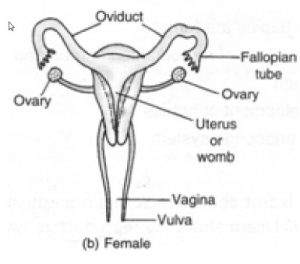
(b) A pair of oviducts or fallopian tubes. The oviducts have a funnel shaped opening over the ovaries and the tube runs up to the uterus. Ova being shed from the ovary enter the funnel of the oviduct and passes through the fallopian tube to reach the uterus.
(c) Uterus or the womb is a sac well supplied with blood vessels along its walls.
The wall develops a spongy cushion (endometrium) which disintegrates every month except when a baby is developing on it. On the upper side of the uterus fallopian tubes open into it. On the lower side, it itself opens out into vagina.
(d) Vagina is a tubular cavity which opens to the outside through an opening called vulva
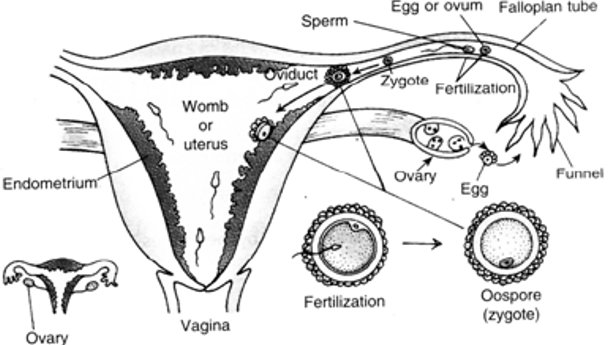
3.3 FERTILIZATION AND EMBRYO DEVELOPMENT
The ovum from the ovary moves into the oviduct (fallopian tube). Millions of sperms are transferred into the female and the sperms swim into the uterus reaching the oviduct. If an egg from the ovary has also reached the oviduct, ONLY one of the sperms may fuse (unite) with it forming a zygote (oospore). The uniting sperm loses its tail outside and only its head enters the egg. Rest of the sperms degenerate. Fusion of male gamete (sperm) and the female gamete (egg) is called fertilization. Fertilization takes place while the egg is passing through the fallopian tube or the oviduct. Zygote then moves into the uterus and gets attached to the endometrium (spongy cushion) on its wall.
In human beings and in animals such as cats, dogs, cows and birds fertilization takes place inside the body of the female. Fertilization taking place inside the body of the female is called internal fertilization.
Points to Note
1. In size, sperm is many times smaller than the size of the egg or ovum.
2. Each of the gametes contains one-half of the chromosomes from its parent cell. One half set of 23 chromosomes come from egg or the ovum (the female gamete) and the other half set of 23 chromosomes come from sperm (the male gamete).
3. The male and the female gametes join together during Fertilization. The zygote formed as a result of the fusion of male and female gametes has one complete set of 23 pairs of chromosomes.
Development of embryo
Embryo is the baby in the early stages of formation. In the case of man, embryo remains within the body of the mother. It is only the baby (fully developed embryo) which takes birth on the completion of gestation period. How babies develop inside the mother ?
Zygote formed as a result of fertilization divides and redivides into a ball of 2, 4, 8,16, 32 and into numerous cells. The cells inside the ball start getting differentiated into organs of a baby forming young embryo. By this time, the embryo gets attached to the wall of the uterus from where it starts drawing nutrition in the form of blood from the mother through a cord (called the umbilical cord). The point of attachment of the cord to the wall of the uterus is called placenta. By the time embryo is five weeks old it will have rudimentary eyes and a beating heart. By the time it is twelve weeks old it is a miniature baby. It takes about 270 to 280 days for embryo to grow into a ‘baby’. This period of growth of the embryo to a baby inside the mother’s womb is called “pregnancy”, or the gestation period. The embryo (the baby) within the womb of the mother during pregnancy is called foetus.
When the foetus is a complete baby with all the organs, the mother gives birth to it.
3.4 CHARACTERS FROM PARENTS TO CHILDREN
Fertilization is the process in which the sperm cell from the father fuses with the egg cell from the mother to form a zygote. The nucleus in each sperm and egg has chromosomes. These chromosomes on the sperm carry the characters of father and the chromosomes on the egg carry the characters of the mother. When these chromosomes unite in pairs in a zygote, they transfer the characters to the new baby. The baby therefore inherits some characteristics from the father and some from the mother. The children, therefore, resemble their parents in body features and also in habits.
- Look to the features on brothers and sisters in your school or neighborhood. Most brothers and sisters look alike.
- Observe carefully the features on your friend and his/her parents. You may find many similarities.
From this we learn that the characteristics from parents are inherited by the children due to the process of fertilization.
3.5 THE SEX OF THE BABY
In each egg there are 23 chromosomes of which 22 are similar to that of a sperm and the 23rd may be different. We describe this 23rd chromosome in egg as X chromosome. All eggs carry X-chromosome only. In some of the sperms the 23rd chromosome may be an X chromosome and in some it may be a Y chromosome. X and Y chromosomes are “sex chromosomes”.
X chromosome stands for female and Y chromosome for male character. When an egg is fertilized by sperm having X chromosome, the zygote is XX, and the baby developing from it is a female baby (a girl child). When an egg is fertilized by sperm having Y chromosome, the zygote is XY, and the baby developing from it is a male baby (a boy child). Sex of the child depends upon the sex chromosome present in the sperm fertilizing the egg. Thus, sperm from the father is responsible for the sex of the child.
Medically it is possible to identify the sex of the foetus, but this practice of learning about the sex of a foetus is illegal and punishable under law.
Some ignorant people misuse the information for aborting foetus (foeticide) of the unwanted child.
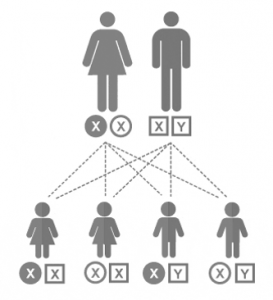
Points to note
- In human body each cell has 46 chromosomes (23 pairs of chromosomes) of which 23 come from an egg (mother) and 23 come from a sperm (father).
- The sex of a baby is determined by the XX and XY chromosomes in a zygote.
- It is a “chance” combination of an egg with an X-sperm or Y-sperm that determines the sex of a child.
Gender Issues
1. Many people blame the mother for giving birth to a girl. Do you think it is true? In many tribes the people have a disliking for having a girl child because of social reasons. They seek the help from doctors for determining the sex of the foetus while inside the mother’s womb. In case, the foetus happens to be female they get it aborted (killing of the foetus inside the mother’s womb). This practice is called female infanticide. Government has made it illegal to find out the sex of the foetus to put a stop to the female infanticide.
3.6 FORMATION OF TWINS
At times mother delivers two or more babies than one. Twins are two babies from a mother taking birth at the same time. Twins may be ‘identical twins’ or ‘paternal twins’.
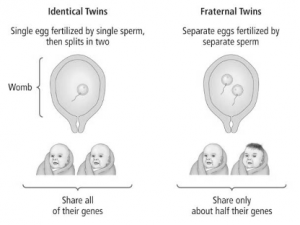
Identical twins come from the same ovum (egg). After fertilization the zygote splits into two, each developing into an independent baby. These twins are ‘identical’ in many respects and are of the same sex.
Paternal twins are the result of double fertilization and they need not be of the same sex. They can be a boy and a girl, or two boys or two girls.
3.7 ENDOCRINE SYSTEM
Hormones are secretions from endocrine glands. These are the chemical substances which are distributed into the various parts of the body through blood to stimulate growth and reproduction.
Endocrine Glands
Endocrine glands and their functioning are called the endocrine system. The endocrine glands secrete the hormones produced by them directly into the blood stream.
There are six endocrine glands in human body. These are :
1. Pituitary gland
2. Thyroid glands
3. Parathyroid glands
4. Adrenal glands
5. Pancreas
6. Testes in males, and Ovaries in females.
In addition to the six endocrine glands listed above an additional gland “thymus Gland” is located in the chest, may be near the heart. This gland is large in babies and gets smaller and reduced as the child grows older. Thymus produces ‘thymosin’ hormone which protects the child from diseases.
Endocrine glands, their location in the body, the hormone they secrete and the activity they control :
1. Pituitary Gland is the master gland located underneath the brain. It regulates the functioning of all other glands. It secretes hormones like growth hormone (GH), Trophic hormone (T.H), Prolactin, Vasopressin and Oxytocin to
(i) stimulate physical growth of the body
(ii) stimulate thyroid gland to secrete Thyroxine hormone
(iii) stimulate adrenal gland to secrete adrenalin
(iv) stimulate mammary glands for the production of milk
(v) regulates blood pressure
(vi) facilitates childbirth
(vii) stimulates testes to produce male sex hormone, the testosterone
(viii) stimulates ovaries to produce female sex hormones, the oestrogen and progesterone.
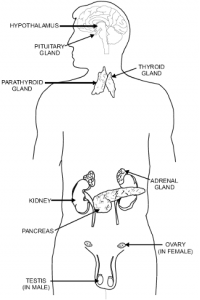
2. Thyroid Gland is bilobed located on windpipe. See picture. It absorbs iodine and other materials to produce :
(i) Thyroxine which regulates physical and mental growth, metabolism (cell formation) and blood cholestrol. Tall, short, fat and thin body is regulated by Thyroxine.
(ii) Calcitonin which maintains calcium level in blood.
3. Parathyroid Glands are four tiny glands located on larynx. Parathyroid hormone (PTH) regulates calcium and phosphate in the body.
4. Adrenal Glands are two, located one on each kidney. They produce hormone adrenalin and four other hormones which regulate emotional status such as excitement, fear, anger, sadness, happiness and increase in energy level in the body. It also regulates.
(i) heartbeat, breathing rate and blood pressure,
(ii) food, sodium and potassium metabolism,
(iii) water balance in blood, and Under stress (fear) secretion from adrenalin increases and results in heavy sweating and lowering of body temperature.
5. Pancreas produces digestive juices which are let into the intestine through ducts. In addition, it has tiny ‘islets of Langerhans’ which secrete two endocrine hormones:
(i) glucagon helps breakdown of glycogen in liver to raise blood glucose level, and
(ii) insulin reduces blood glucose level. Deficiency of insulin results in diabetes.
6. Sex Glands are testes in male and ovaries in female. They secrete ‘sex hormones’, which are responsible for male or female characteristics.
(a) Testes in male produce the hormone ‘testosterone’ which helps
- male sex characters
- production of sperms.
Sex Glands are testes in male and ovaries in female. They secrete ‘sex hormones’, which are responsible for male or female characteristics.
(b) Ovaries in female produce two hormones:
- Oestrogen which helps in regulating whole set of female sex characters, including formation of ova.
- Progesterone to regulate reproductive (menstrual) cycle.
3.8 INFANCY TO ADOLESCENCE
From baby to childhood is infancy. This period is generally up to the age of 7 to 8 years. Then, begins the reproductive maturity. Girls at the age of 11 to 12 years and boys at the age of 14 to 15 years attain puberty (the reproductive maturity). Simultaneously, some major changes in the body of the girls and boys take place which continue up to the age of 19 or 20 to bring about complete maturity. This period of development from childhood to womanhood or manhood is the period of adolescence.
Adolescence is a phase of rapid physical, mental and sexual growth. This growth can be confusing to youngsters as they may feel certain emotional and social interactions.
Changes in the Body of a Youth during Adolescence
The pituitary gland activates all other endocrine glands from time to time and they start secreting hormones which bring about many changes in the body of the youth. These changes are
In Boys
- Increase in height and better development of muscles.
- Change in body shape with broader shoulders and wider chests.
- Voice change due to better growth of larynx, which may protrude on the throat forming ‘Adam’s apple! The voice in boys is deep and hoarse.
- More of secretions from oil glands (Sebaceous Glands) making the skin oily and shining.(glowing).Many youths develop acne and pimples on their faces.
- Attain mental, intellectual and emotional maturity. Confidence building takes place. Learning capacity increases.
- Secondary sex characters develop :
- In both, boys and girls, hair starts growing in arm pits and the pubic region above the thighs.
- Moustaches and beard appear due to growth of facial hair, a distinguishing character of males.
- Reproductive functioning begins with the release of Follicle Stimulating Hormone (FSH) from pituitary gland which makes testes to release testosterone hormone to initiate the formation of sperms (gametes) in the testes.
- Primary and secondary sex characters are activated with the release of male hormone (testosterone) from testes.
In Girls
- Increase in height and better development of muscles.
- Change in body shape with broader shoulders, narrow waist and the region below the waist and around the hip girdle gets wider.
- Voice change without protruding larynx and high pitched voice (shrill but sweet).
- More of secretions from oil glands (Sebaceous Glands) making skin soft, oily and glowing. May develop acne (pimples).
- Attain mental, intellectual and emotional maturity. Confidence building and learning capacity increases.
- Secondary sex characters develop :
- In both, boys and girls, hair start growing in arm pits and the pubic region above the thighs.
- Hormone from ovaries, the estrogen makes the breasts develop along with milk secreting glands inside. However, production of milk is under the control of a hormone from pituitary gland which gets activated only after a baby is delivered. Milk from the mother is available to the baby for about a year.
- Reproductive functioning begins with the maturation of sex organs and with the secretion of Follicle Stimulating Hormone (FSH) from the pituitary gland. This makes the ova (eggs) mature in the ovaries and preparing the uterus to receive zygote. In girls puberty begins at the age of10 to 12 years.
During puberty, ova begin to mature in the ovaries. One ovum from any one of the two ovaries is released into the fallopian tube once in about 28 to 30 days. The sperm from male joins the ovum in the fallopian tube to form zygote. The zygote moves into the uterus and gets attached to the spongy and cushiony wall formed in the uterus. This is the onset (beginning) of pregnancy. - Before a zygote is received in the uterus, the uterus wall becomes thick with a lining of soft and spongy tissue full of blood vessels. This is to receive the zygote. In case fertilization does not take place, the ovum (egg) along with the lining and the blood vessels is shed off. This results in bleeding in women which continues for 2 to 3 days. This is called menstruation. Since menstruation occurs once in about 28 to 30 days it is also called “period” or menstrual cycle. First menstrual flow is called menarche and begins with puberty. At the age of 45 to 50 years the reproductive ability stops and then menstrual cycle also stops. Stoppage of menstruation is called menopause,
which is the termination of puberty.
3.9 REPRODUCTIVE HEALTH
During adolescence and during parenthood both the parents must take care of personal health and hygiene. For this, one needs:
1. Physical Exercise : Exercise and outdoor games keep the body fit and strong. Rope skipping is one of the good exercises for girls and boys. Walks and breathing fresh air is good for health.
2. Personal Hygiene : Right from childhood to the end of the life it is necessary to observe personal hygiene in every walk of life. For this :
- Take bath daily at least once a day. Teenagers and adults should be particular about bath since sweat may make the body smell bad. Sweat is also a good abode for the germs causing various diseases.
- Clean all the body parts, including reproductive organs. Foreskin on penis and urethra should be cleaned to save them from infection.
- Proper nutrition : Balanced diet during adolescence helps in proper development of reproductive organs and a beautiful healthy body.
3. No drugs and No smoking : Drugs are bad not only for health but for intelligence also. Drugs make one dull in learning and in physical activities. Syringes used for drugs may also infect you with AIDS
(Acquired Immune – deficiency syndrome).
4. Sexual contact of any kind which may result in (AIDS) or any other sexually transmitted diseases TD) should be avoided. Also, adolescent pregnancy is harmful. The right age for motherhood is 20above, when one crosses “teens”. A couple should take up the responsibilities of parenthood only when properly settled in life. This keeps one mentally, physically, emotionally and financially healthy and only then able to care for the child in a better way. Marriageable age prescribed under law is years for girls and 21 years for boys. Below this age they are ‘minors’ and the marriage between minors is illegal. Reproductive health care is a must for healthy parents for having healthy children.
3.10 GENDER ISSUES AND SOCIAL TABOOS
It has been since times immemorial that the man became selfish and he discriminated against the “fair sex”, the girls or the female child.
Since women were more apt to work in homes and fie they were kept occupied as labour and man used to be busy whiling away his time in gossiping am in games. To be exact ‘most men lived as parasite on women’. She was the bread earner. One used to keep many wives. Even today when the law is ‘one man one wife’, in certain tribal societies they permit man to keep more than one wife.
In contrast, in many of our social groups, girls are considered a burden since marrying them subjugates them to the families in which their sisters or daughters are married. Whereas, in some social groups “dowry” has become a menace. To overcome all this, “female foeticide” has become a practice. Overall result is that in some areas the female population is on the decline. There are less number of girls available to marry the boys.
We must leave things for nature to decide. Chance combination of X and Y sperms with ova, when left to nature automatically, results in balancing the population of the two sexes. Then, we must respect WOMEN, since only they help in bringing up of babies, and not the man. Today, women have been able to do better than men in every field of life.
Some Myths and Social Taboos
Due to ignorance there are many misgivings about man and woman and their sex life. Some of the myths 7 are :
- Girls are not as intelligent as the boys are.
- Girls are not capable of performing certain feats as boys.
- Loss of semen is the loss of energy.
- A girl should not handle food during menstruation.
- Physical contact (even touching) makes a girl pregnant.
- The mother is responsible for the sex of her child. A mother of many girls is considered ‘unlucky’ and responsible for bearing female child only.








